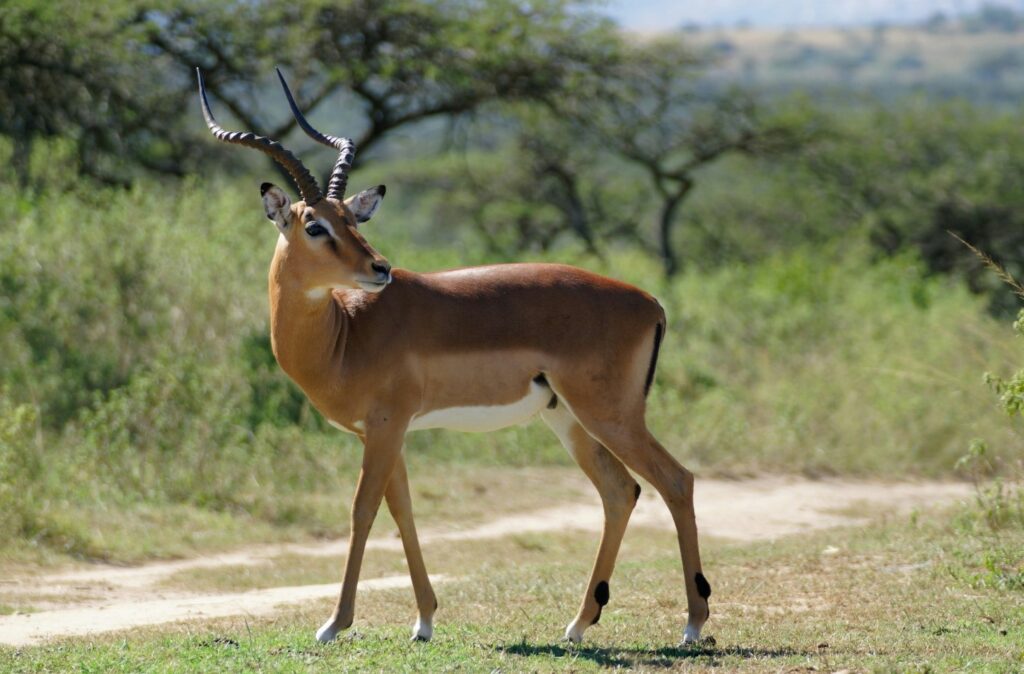One of the most prized and sought-after trophies in the continent. The Kudu is a large antelope with spectacular spiral horns that can reach up to 6 feet in length. It is also a master of camouflage and stealth, making it a formidable quarry for even the most experienced hunters.
To hunt the Kudu, you will have to follow different regulations and obtain the necessary permits. The best time to hunt the Kudu is during the dry season, when the vegetation is less dense and the animals are more active. You will also need a powerful rifle, preferably in the .270 to .300 caliber range, to ensure a clean and humane kill.
The Kudu can be found in various regions of Africa, but some of the most popular destinations are South Africa, Namibia, Zimbabwe, and Botswana. These countries offer diverse and scenic landscapes, ranging from open savannas to thick bushvelds, where the Kudu thrives. You will have to employ stealth and patience to stalk the Kudu, as it has excellent hearing, vision, and smell. You will also have to look for clues of its presence, such as tracks, droppings, and browsing marks. To increase your chances of success, you can choose Shooting Stix Safari’s as we know the area and the habits of the Kudu.
Hunting the Kudu is not only a thrilling experience, but also a rewarding one. You will have the chance to admire the beauty and grace of this magnificent animal, and to take home a trophy that will make you proud. You will also have the satisfaction of knowing that you have hunted ethically and respectfully, contributing to the conservation and management of the wildlife and the environment.
If you are interested in booking a Kudu hunting trip, please contact us for more details. We will help you find the best package and destination for your needs and preferences. Don’t miss this chance to live the hunting adventure of a lifetime!
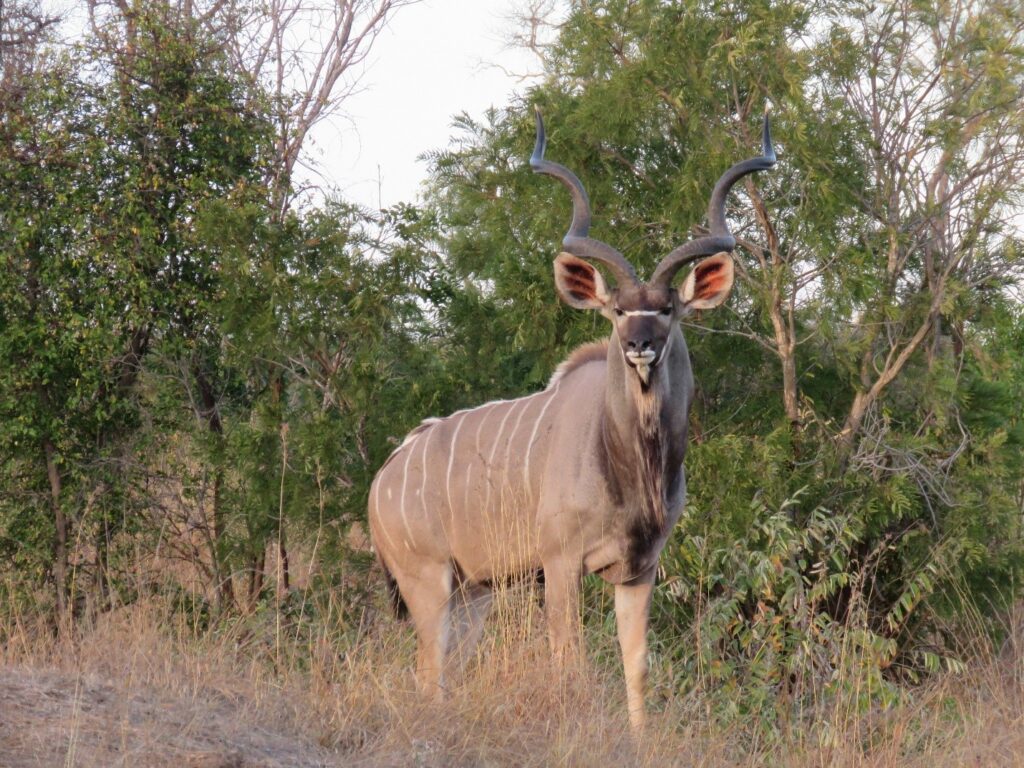
If you want to experience the thrill of hunting one of the most iconic and majestic animals of the continent then African Zebra hunting is the perfect choice for you!
The African Zebra, with its striking black and white stripes, symbolizes the beauty and resilience of the African savanna. Zebras are highly social and intelligent animals, living in large herds that can number in the thousands. They have a complex communication system, using vocalizations, body language, and facial expressions to convey their emotions and intentions. They are also very agile and fast, capable of running up to 65 km/h (40 mph) to escape predators. Hunting Zebra requires skill, patience, and respect, as these animals will not give up easily and will often challenge the hunter with their curiosity and caution.
When planning a hunting trip for Zebra, understanding the hunting seasons is essential, as regulations can vary across different countries and regions within Africa. Typically, Zebra hunting is permitted during specific times of the year when populations can sustain harvest, often coinciding with dry seasons when water sources are limited, making them more predictable in their movements.
The most relevant regions for Zebra hunting include countries such as South Africa, Namibia, and Tanzania, where expansive grasslands and acacia woodlands provide prime Zebra habitat. Depending on the location, you can encounter different subspecies of Zebra, such as the plains Zebra, the mountain Zebra, or the rare Grevy’s Zebra. Each subspecies has its own distinctive features, such as stripe patterns, size, and behavior, adding to the diversity and challenge of the hunt.
In terms of equipment, a rifle caliber ranging from .30-06 to .375 is recommended, offering ample power to ethically take down these robust animals. A good quality scope, binoculars, and rangefinder are also essential, as Zebras can blend in with their surroundings and often require long-range shots.
If you are ready to embark on a Zebra hunting expedition, you can contact us to book your hunt. We offer a variety of packages and options to suit your needs and budget. We have years of experience and expertise in organizing and conducting Zebra hunts, and we guarantee you a safe, enjoyable, and memorable adventure in the African savanna. Don’t miss this opportunity to hunt one of the most beautiful and challenging animals in the world. Book your Zebra hunt today!
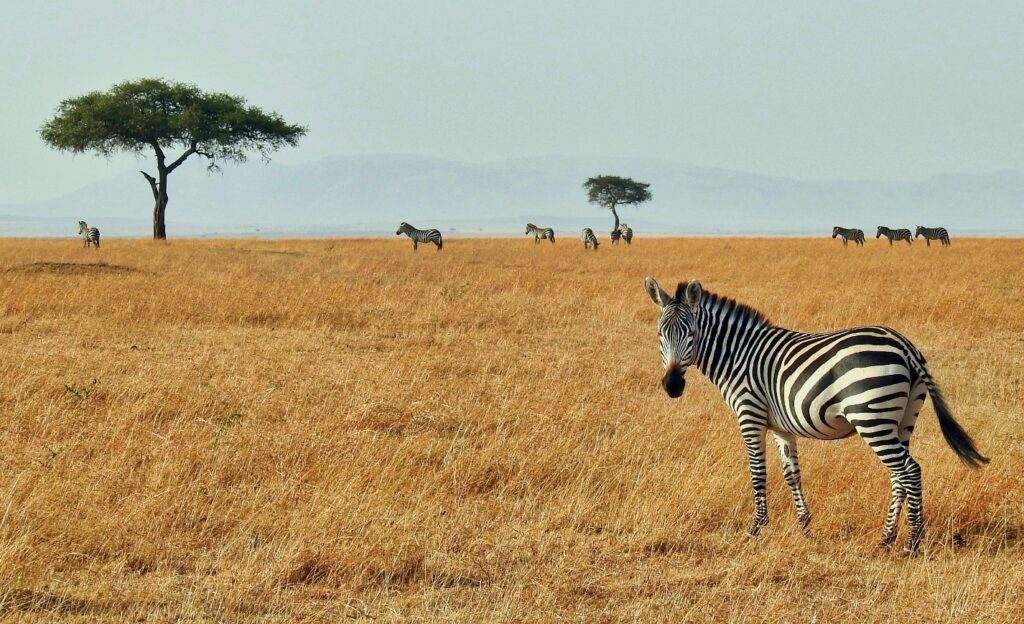
The African Eland (Tragelaphus oryx) is a living example of the magnificence of the natural world. This enormous antelope invites daring hunters to join it for an incredible safari adventure with its gracefully spiraling horns. Discover the excitement of the hunt and the beating heart of Africa here, among the sun-drenched savannas and vast plains.
The Eland is the world’s largest antelope, boasting a weight range of 590 to 997 kilograms (that’s a whopping 1,300 to 2,200 pounds!). Males stretch to 2 to 3 meters in length, while females measure between 1 to 3 meters. At the shoulder, they stand approximately 2 meters tall. Their fawn or tawny coats mature into gray or bluish-gray hues with age. The oldest Elands take on an almost regal black hue. Both males and females sport tightly spiraled horns, with females’ horns being longer and more delicate. A distinctive tuft of black hair graces the male’s dewlap, emphasizing their majestic presence.
Elands thrive in open grasslands, where their imposing silhouettes blend seamlessly with the golden expanse. These resilient creatures adapt even to semi-desert environments, particularly in dry Namibia. Sparse woodlands and savannah grasslands provide their more natural habitats, while they gracefully avoid thick forests and swampy areas.
Eland hunting is permitted during specific windows when populations stabilize. The dry season, with its crystal-clear visibility, draws hunters. Elands congregate around water sources, presenting prime opportunities. Securing permits is non-negotiable. Respect local laws and conservation efforts. Each shot should echo ethical responsibility.
Choose a rifle caliber between .30-06 and .375 for humane takedowns. South Africa, Namibia, Zimbabwe, and Botswana beckon. Their vast savannas and open plains harbor Elands aplenty. Patience is your ally. Stalk silently, position strategically, and respect their keen senses. Elands detect danger swiftly. Their insights into Eland behavior and habitat preferences enhance your chances of success while upholding ethical hunting practices and conservation ideals.
An Eland hunting expedition transcends mere sport. It’s a communion with Africa’s soul—a chance to breathe the same air as these majestic creatures. As the sun rises over the savanna, your heart races, and the pulse of the chase reverberates through your veins. Are you ready to connect with nature’s primal rhythm? Join us in the heart of Africa’s wilderness, where the Eland awaits your challenge.
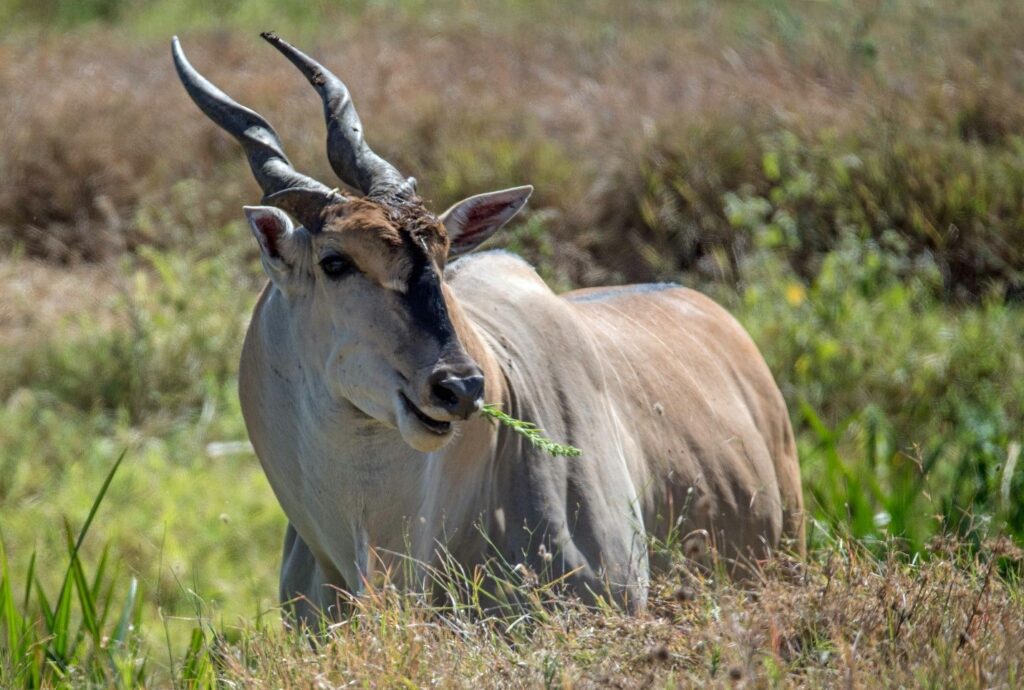
Hunting Gemsbok is not only a thrilling and satisfying adventure, but also a way to contribute to the conservation and management of this remarkable species.
A Gemsbok (Oryx gazella) is a large antelope that belongs to the oryx genus. It has a distinctive appearance, with a tan or brown coat, black and white facial markings, and long, straight horns that can reach up to 1.2 meters in length. Both males and females have horns, which they use for defense and dominance. Gemsbok are herbivorous, feeding on grasses, leaves, and roots. They can survive in harsh conditions, as they can tolerate high temperatures and go without water for long periods of time. They are also social animals, living in herds of up to 40 individuals, led by a dominant male.
Gemsbok are native to the arid and semi-arid regions of southern Africa, especially Namibia, Botswana, and South Africa. They prefer open savannas, grasslands, and deserts, where they can find food and water sources. They are also adaptable, and can be found in other habitats, such as mountains and woodlands. Gemsbok are widely distributed across their range, and their population is estimated to be around 373,000 individuals. They are not considered endangered, but they face threats from habitat loss, poaching, and predation.
Generally, Gemsbok hunting is allowed during specific times of the year, when the population is stable and the environmental conditions are favorable. These times often coincide with the dry season, which usually lasts from May to October, depending on the location. During the dry season, Gemsbok tend to congregate around water sources, making them easier to locate and approach.
Gemsbok hunting is a challenging and rewarding experience, as these animals are strong, fast, and wary. They have excellent eyesight, hearing, and smell, and can detect danger from a distance. They can also run at speeds of up to 60 km/h, and can use their horns to fend off predators and hunters. Therefore, hunters need to be well-prepared and skilled to hunt Gemsbok successfully.
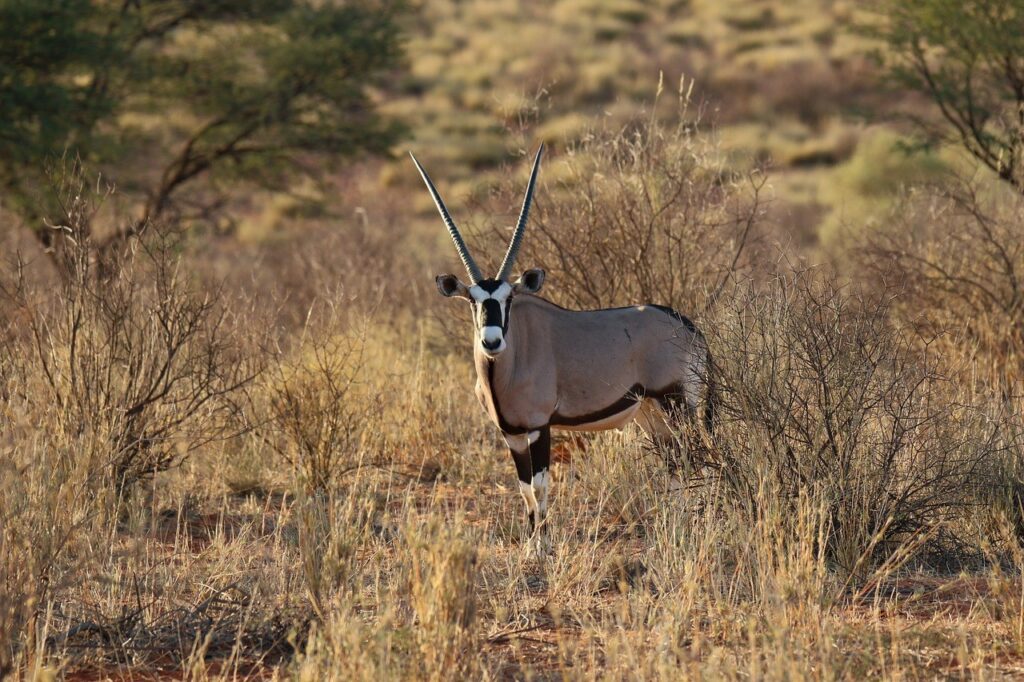
If you are looking for a fun and exciting hunting adventure in Africa, you might want to consider hunting the African Impala, a graceful and elegant antelope species that can leap up to 3 meters high and 10 meters long.
An Impala (Aepyceros melampus) is a medium-sized antelope that belongs to the bovid family. It has a reddish-brown coat, white underparts, and black markings on the ears, tail, and legs. The most distinctive feature of the Impala is its lyre-shaped horns, which can reach up to 90 cm in length. Only males have horns, which they use for fighting and display. Impala are herbivorous, feeding on grasses, herbs, and fruits. They can adapt to different environments, as they can drink water regularly or rely on the moisture from their food. They are also social animals, living in mixed-sex herds of up to 200 individuals, or bachelor groups of males.
Impala are native to the savannas and woodlands of eastern and southern Africa, especially South Africa, Namibia, and Zimbabwe. They prefer areas with abundant vegetation and water sources, where they can find food and shelter. They are also migratory, moving seasonally between wet and dry areas. Impala are widely distributed across their range, and their population is estimated to be around 2 million individuals. They are not considered endangered, but they face threats from habitat loss, poaching, and predation.
Impala hunting is allowed during specific times of the year, when the population is stable and the environmental conditions are favorable. These times often coincide with the dry season, which usually lasts from June to October, depending on the location. During the dry season, Impala tend to be more visible and active, making them easier to locate and approach.
Impala hunting is a fun and rewarding experience, as these animals are agile and alert. They have excellent eyesight, hearing, and smell, and can detect danger from a distance. They can also run at speeds of up to 80 km/h, and can evade predators and hunters with their impressive leaps and turns. Therefore, hunters need to be well-prepared and skilled to hunt Impala successfully.
